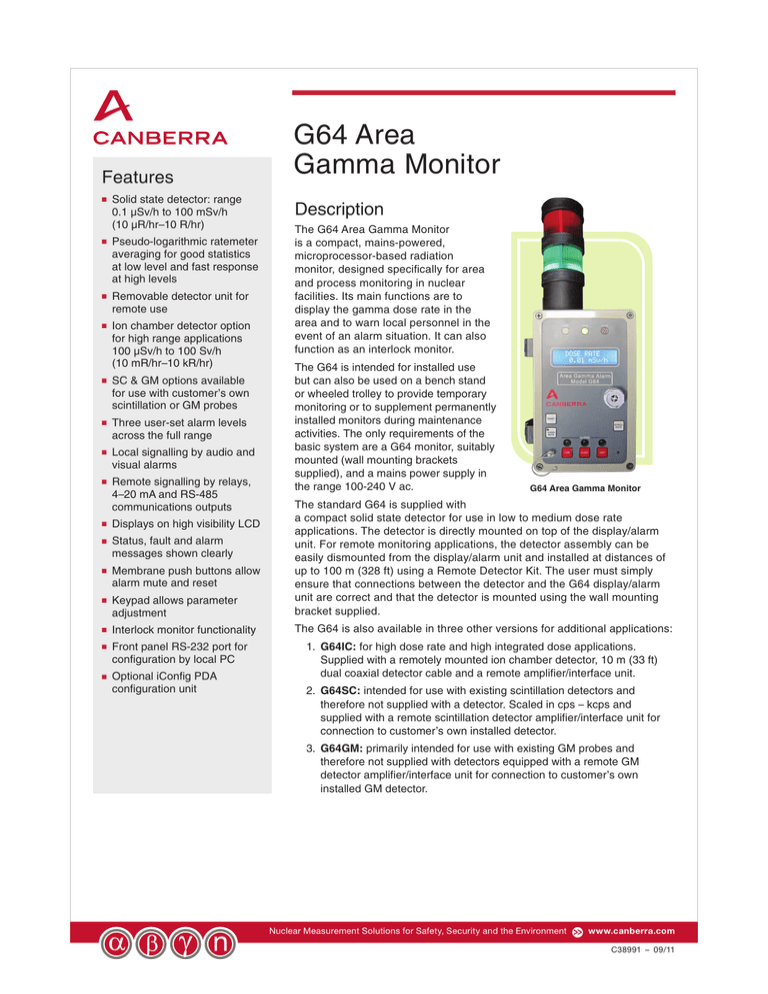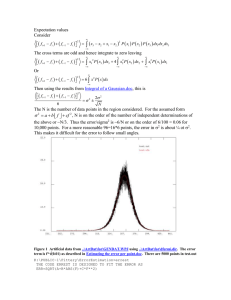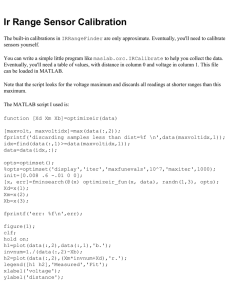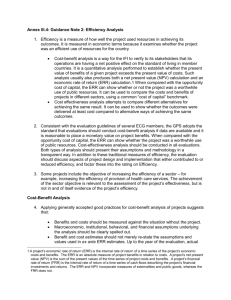
Features
Solid state detector: range
0.1 µSv/h to 100 mSv/h
(10 µR/hr–10 R/hr)
■
Pseudo-logarithmic ratemeter
averaging for good statistics
at low level and fast response
at high levels
■
Removable detector unit for
remote use
■
Ion chamber detector option
for high range applications
100 µSv/h to 100 Sv/h
(10 mR/hr–10 kR/hr)
■
SC & GM options available
for use with customer’s own
scintillation or GM probes
■
Three user-set alarm levels
across the full range
■
Local signalling by audio and
visual alarms
■
Remote signalling by relays,
4–20 mA and RS-485
communications outputs
■
G64 Area
Gamma Monitor
Description
The G64 Area Gamma Monitor
is a compact, mains-powered,
microprocessor-based radiation
monitor, designed specifically for area
and process monitoring in nuclear
facilities. Its main functions are to
display the gamma dose rate in the
area and to warn local personnel in the
event of an alarm situation. It can also
function as an interlock monitor.
The G64 is intended for installed use
but can also be used on a bench stand
or wheeled trolley to provide temporary
monitoring or to supplement permanently
installed monitors during maintenance
activities. The only requirements of the
basic system are a G64 monitor, suitably
mounted (wall mounting brackets
supplied), and a mains power supply in
the range 100-240 V ac.
G64 Area Gamma Monitor
Keypad allows parameter
adjustment
The standard G64 is supplied with
a compact solid state detector for use in low to medium dose rate
applications. The detector is directly mounted on top of the display/alarm
unit. For remote monitoring applications, the detector assembly can be
easily dismounted from the display/alarm unit and installed at distances of
up to 100 m (328 ft) using a Remote Detector Kit. The user must simply
ensure that connections between the detector and the G64 display/alarm
unit are correct and that the detector is mounted using the wall mounting
bracket supplied.
Interlock monitor functionality
The G64 is also available in three other versions for additional applications:
Front panel RS-232 port for
configuration by local PC
1.
G64IC: for high dose rate and high integrated dose applications.
Supplied with a remotely mounted ion chamber detector, 10 m (33 ft)
dual coaxial detector cable and a remote amplifier/interface unit.
Displays on high visibility LCD
■
Status, fault and alarm
messages shown clearly
■
Membrane push buttons allow
alarm mute and reset
■
■
■
■
Optional iConfig PDA
configuration unit
■
2.
G64SC: intended for use with existing scintillation detectors and
therefore not supplied with a detector. Scaled in cps – kcps and
supplied with a remote scintillation detector amplifier/interface unit for
connection to customer’s own installed detector.
3.
G64GM: primarily intended for use with existing GM probes and
therefore not supplied with detectors equipped with a remote GM
detector amplifier/interface unit for connection to customer’s own
installed GM detector.
Nuclear Measurement Solutions for Safety, Security and the Environment www.canberra.com
C38991 – 09/11
G64 Area Gamma Monitor
Operating Principle
A block diagram of the G64 with solid state detector
is shown below. Gamma radiation interactions in the
G64 solid state detector produce charge pulses whose
magnitude and frequency are proportional to the
incident energy and dose rate. These charge pulses
are amplified and shaped to produce a series of voltage
pulses, each of which, if it is above the minimum
energy that the G64 has been designed to detect,
triggers an RS-422 pulse which is sent to a scaler. The
scaler contents are read out at regular intervals by a
microprocessor and converted to the corresponding
radiation dose rate. An adaptive software algorithm
is used to ensure both a rapid response to step
changes and good statistical accuracy, even at low
dose rate levels. The microprocessor controls the
G64’s indicators, alarm annunciators and external
communications.
Ion Chamber Detector
The G64 Ion Chamber Detector is a small,
environmentally-sealed (IP65) gamma radiation
detector, which is designed to replace the standard
solid state semi-conductor detector in high dose/high
dose rate environments.
The detector (inside the high dose rate environment) is
connected to its remote amplifier/interface unit (outside
the high dose rate environment) by 10 m (33 ft) of special connecting cable (supplied). The amplifier/interface
supplies the high voltage required by the ion chamber
and converts the low level current signal to a frequency
signal for transmission to the G64 display/alarm unit via
up to 50 m (164 ft) of standard twin twisted pair cable.
The amplifier/interface unit also receives 12 V dc power
from the G64 display/alarm unit via this cable. In low
dose rate areas (<20 µSv/hr) the G64IC ion chamber
may need an internal 18 kBq (0.5 µCi) 241Am holdup
source installed inside in order to give a constant indication that the detector is operating (as required under
International Standards for Monitors).
G64 SC and GM Systems
Both of these systems are supplied without detectors,
as their primary purpose is to replace or upgrade
old system electronics where the customer desires
to retain the existing detector. Each system has a
remote amplifier/interface unit designed to supply
the high voltage required by the detector and amplify
the detector pulses and convert them to RS-422
format for transmission to the G64 display/alarm unit.
Both the SC and GM amplifier/interface units have
a very wide range of gain and high voltage settings,
to allow them to be set up to match a wide variety of
scintillation or GM detectors.
INPUTS
USER INTERFACE
RADIATION DETECTION
Semiconductor
Detector
Charge
Amplifier
Comparator
Main Voltage
Amplifier &
Shaping
Keypad
Power
Supply
Scaler
ALARM ANNUNCIATORS
COMMUNICATIONS
Beacon
RS-232/RS-485
Sounder
Microprocessor
Current Loop
Relays
RS-422 Pulse
Digital
Display
Status
LEDs
INDICATORS
OUTPUTS
G64 Area Gamma Monitor
Configuration
The G64 incorporates a universal power supply
that operates over the mains range 100-240 V ac.
Therefore, no switches or links are required to operate
at any voltage within this range. On power-up, the
G64 will perform a self-test and when this has been
successfully completed it will commence monitoring.
Using a Remote Detector
To remove the detector assembly, simply open the
front panel of the G64, pull out the retaining pin and
unplug the assembly from the top of the unit. Install and
connect the detector using a G64 Remote Detector Kit,
which consists of:
■detector mounting bracket
■cover plate for top of main G64 unit
■cable (standard lengths 10 m, 25 m or 100 m),
terminated with a 9-way D-type connector that
plugs directly into the remote detector.
The flying lead of the cable is connected to the screw
terminal block within the instrument. The cable is a
twin twisted pair; two wires for DC power and two for
RS-422 pulses from the detector. The same cable
connection is used for the IC, SC and GM remote
amplifiers/interfaces.
Indicators
Readings and other data are displayed on a large
16 character x 2 line liquid crystal display (LCD)
provides a more precise indication of the dose rate. It is
permanently backlit for easy viewing.
The G64 can be configured via the front panel RS-232
port using the PC Config software supplied with the
unit or the optional iConfig PDA. This software allows
access to all user-settable parameters. In addition,
the most commonly accessed parameters (e.g. alarm
levels) can be accessed via the front panel keys using
a ‘hidden’ passcode key sequence. This access can be
disabled for additional security if required.
Parameters accessible via the keypad include:
■ detector type, calibration factor and dead time
■alarm levels and responses
■fault condition responses
■alarm level detection factor
■high alarm delay time
■detector nil-count timeout period
■analogue output (4-20 mA) start decade and range
(number of decades)
■averaging algorithm to be used (pseudo-log or
fixed time).
The status of the operating parameters may be viewed
at any time by means of soft keys and the LCD display
on the front panel.
In the event of an alarm situation, two soft keys are
available on the front panel to allow the user to mute
the sounder (the beacon continues to flash) or to reset
the instrument.
The display indicates the current alarm level setting
when the corresponding soft key is pressed. The LCD
also indicates the current system parameters when the
‘scroll data’ soft key is pressed.
When the G64 is operating normally, the green beacon
will be constantly illuminated. The G64 has three light
emitting diodes (LEDs) located above the LCD display,
which indicate whether it is normally operational, in a
fault condition or working off its internal battery (‘AC
fail’).
Alarms and Annunciators
The G64 has three alarm thresholds, all of which
are user settable. The ‘alert’ and ’high’ alarms are
triggered when the ambient radiation level exceeds
these thresholds. Both can be set across the range of
the instrument, although the alert level must always
be less than the high level. The user can select
which annunciators are associated with these alarms,
whether they are to be latched or unlatched, and what
detection factor is to be applied.
G64 Area Gamma Monitor
The detection factor allows the user to set thresholds at
a fixed number of standard deviations above and below
each alarm level to provide confidence that an alarm is
genuine rather than a statistical fluctuation.
For example, if an alarm level in µSv/h is equivalent
to 100 cps recorded in the detector and the detection
factor is set to 2 sigma, then the alarm will be
generated when the count rate exceeds 120 cps and
will be maintained until it falls below 80 cps. The ‘low’
alarm threshold differs from the other two in that, in this
case, the alarm is triggered if the radiation falls below
this level. Its main purpose is to identify a detector
failure and it therefore shares the same relay as the
equipment fault.
Alarm annunciation is by means of:
■
the red beacon,
which flashes
■
the sounder,
which can be
configured by
the user to one
of 24 different tones and
frequencies (e.g.
to avoid confusion with other
plant devices) via
switches accessible behind the
front door. LEDs,
located below
the LCD, indicate
which of the three
alarm conditions
has been registered. The user
may suppress
alarm annunciation for either or both of the activity
alarms if required.
In the event of a sustained mains failure, full operation is
supported by an internal battery for at least 30 minutes.
Outputs and Communications
Connections to the G64 are via unplugable screw
terminal blocks, accessible, with the front panel open,
through compression glands on the underside of
the instrument. The G64 enables the user to control
external devices and to transmit data to local or remote
locations via:
■three sets of volt-free changeover contacts for the
alert and high activity alarms and the low activity
alarm/equipment fault condition. Relays can be
configured to operate in the fail-safe mode, i.e.
normally energized (default setting) or in normally
de-energized mode
■RS-232 serial port for communication to local PC
or PDA
■RS-485 serial port for communication with remote
monitoring systems
■current loop output for driving a chart recorder
■RS-422 pulse output for connection to distributed
control systems.
Diagnostics
The G64 incorporates a number of hardware and
software diagnostics to identify the nature of any fault
in the operation of the instrument. Faults that will be
detected are:
■5 V, 12 V or 24 V dc line fault (check)
■low internal battery voltage
■detector fault
■mains failure
■microprocessor fault
Occurrence of any of these conditions will cause the
green beacon to flash and will trip the ‘equipment fault’
relay. The nature of the fault will be displayed on the
LCD.
The G64 includes a back-up battery to provide up to
5 seconds immunity to temporary mains interruptions
and up to 30 minutes of full operation (with AC fail
indication) if the interruption is sustained. During this
period it will emit a constant audio tone and flashing
green beacon and the ‘AC fail’ LED will be illuminated.
G64 Interlock Monitor
The three sets of volts-free changeover contacts
provided in the monitor can be configured for interlock
control. In these applications the beacons may be
removed if not required, and the sounder disabled.
G64 Area Gamma Monitor
Related Equipment
D1 Slave Alarm
The D1 Slave Alarm is designed for use with any
monitoring instrument, including the G64 Area Gamma
Monitor, whose output provides a pair of volts-free relay
contacts. In its standard configuration the Slave Alarm
is actuated when the relay contacts open, signalling the
alarm condition with an audio sounder and a flashing
red beacon. The D1 is mains powered and can be set
for use with a 110 V or 240 V ac power supply.
Accessories
■ remote Detector Kit (10 m, 25 m, 100 m) (33 ft,
82 ft, 328 ft) includes pre-terminated cable,
blanking plate and wall mount for detector
■
bench stand with RCD and MCB – 110 V ac or
240 V ac versions (/B110 or /B240 option)
■
■
trolley mount with RCD and MCB – 110 V ac or
240 V ac versions (/T110 or /T240 option)
test pulse generator
RADACS™
G64 is compatible with CANBERRA’s RADACS
environmental surveillance and monitoring software.
RADACS allows the implementation of large networks
of varied monitoring instruments to provide total
surveillance and control of radiological conditions
throughout plants and facilities.
G64 ACCESSORIES and OPTIONS
PART
DESCRIPTION
G64CAL
CALIBRATION OF STD G64
G64ICCAL
CALIBRATION OF G64 IC SYSTEM
G64DA
G64 DETECTOR ASSEMBLY (spare)
G64RD/A
G64 AREA/INTERLOCK GAMMA MONITOR REMOTE DET KIT (10 m) (33 ft)
G64RD/B
G64 AREA/INTERLOCK GAMMA MONITOR REMOTE DET KIT (25 m) (82 ft)
G64RD/C
G64 AREA/INTERLOCK GAMMA MONITOR REMOTE DET KIT (100 m) (328 ft)
G64TB
G64 TEST BOX (PULSE GENERATOR)
G64SA
D1 SLAVE ALARM UNIT
iConfig
ICONFIG POCKET configuration unit for iCAM and G64
ICAM/B240
BENCH STAND C/W CABLES and MAINS ISOLATORS
ICAM/B110
BENCH STAND C/W CABLES and MAINS ISOLATORS
ICAM/T
TROLLEY KIT bare/unwired trolley for wheeled transport of bench stand mounted systems
ICAM/T240
TROLLEY C/W CABLES and MAINS ISOLATORS
ICAM/T110
TROLLEY C/W CABLES and MAINS ISOLATORS
G64 Area Gamma Monitor
Specifications
PHYSICAL
RADIOLOGICAL STANDARD – IEC532, installed dose
rate meters, warning assemblies and monitors for X- and
gamma radiations of energy between 50 keV and 7 MeV
(1992).
■ RESPONSE TIME – <6 seconds to 90% of final step
change value.
■ DYNAMIC RANGE – 0.1 µSv/h to 100 mSv/h
(10 µR/hr–10 R/hr).
■
G64 SOLID STATE DETECTOR
LINEARITY – ±10% from 1 µSv/h to 100 mSv/h
(137Cs radiation).
■ ENERGY RESPONSE – 70 keV to 7 MeV ±30%
normalized to 137Cs.
■ POLAR RESPONSE – ±20% over 4p for 137Cs.
■ ENVIRONMENTAL – Operating temperature 0 °C to
+40 °C (32 °F to 104 °F). Relative humidity to 85%
(non-condensing).
■ ENVIRONMENTAL PROTECTION – IP65 when
mounted on G64.
■ POWER REQUIREMENTS – 12 V dc, typically 30 mA
(supplied by G64 Display/Alarm unit).
■ DIMENSIONS – 85 x 75 x 60 mm (3.3 x 2.9 x 2.4 in.).
■ WEIGHT – 0.5 kg (1.1 lb).
■
G64IC ION CHAMBER SYSTEM
MEASUREMENT RANGE – 100 µSv/h to 100 Sv/h
(10 mR/hr–10 kR/hr).
■ TEMPERATURE RANGE – 0 °C to 40 °C (32 °F to
104 °F).
■ ENVIRONMENTAL PROTECTION – IP65.
■ POWER REQUIREMENTS – 12 V dc, typically 100 mA
(supplied by G64 Display/Alarm unit).
■ DIMENSIONS – Detector: Approximately 230 mm (9 in.)
long x 50 mm (2 in.) Diameter. Amplifier/Interface: 210 x
80 x 63.5 mm (8.3 x 3.1 x 2.5 in.).
■
G64SC SCINTILLATION SYSTEM
MEASUREMENT RANGE – Range 0.1 cps – 100 kcps.
AMPLIFIER INTERFACE UNIT/POWER SUPPLY
– +12 V dc, 210 mA (supplied by G64 Display/Alarm
unit).
■ TEMPERATURE RANGE – 0 °C to +40 °C (32 °F to
104 °F).
■ HUMIDITY – 0%-85%, non condensing.
■ DIMENSIONS – 65 x 210 x 80 mm (2.6 x 8.3 x 3.1 in.)
(H x L x W) (including mounting plate).
■ WEIGHT Remote interface box – <3 kg (6.6 lb).
■ HIGH VOLTAGE – +500 V to +1800 V into >20 MW load
impedance.
■ DISCRIMINATOR THRESHOLDS – 0.1 V, 0.5 V or 2.5 V.
■ TRANSFER FACTOR – 8 mV/pC or 160 mV/pC.
■ INPUT IMPEDANCE – 50W.
■ PULSE SHAPING – 1 µs.
■
■
RADACS is a trademark of Canberra Industries, Inc.
© 2011 Canberra Industries, Inc. All rights reserved.
G64GM SYSTEM
MEASUREMENT RANGE
RANGE – dependent on GM probe used: typically
0.1 µSv/h to 7.5 mSv/h (10 µR/hr–0.75 R/hr) with
MC10P probe. 100 µSv/h–10 Sv/hr (10 mR/hr–1 kR/hr)
with MC10PS probe.
■ AMPLIFIER INTERFACE UNIT/POWER SUPPLY
– 12 V dc 170 mA.
■ TEMPERATURE RANGE – 0 °C to +40 °C (32 °F to
104 °F).
■ HUMIDITY – 0%-85%, non condensing.
■ DIMENSIONS – 65 x 210 x 80 mm (2.6 x 8.3 x 3.1 in.)
(H x L x W) (including mounting plate).
■ WEIGHT Remote interface box – <3 kg (6.6 lb).
■
DISPLAY/ALARM UNIT
DISPLAY – LCD digital output 6 decade Meter D
analogue indication.
■ OUTPUTS – Three Fail-safe relays for faults and
alarms, each with two sets of changeover contacts.
RS-232/RS-485 interfaces RS-422 format pulse output.
Current loop (4-20 mA).
■ ENVIRONMENTAL PROTECTION – IP54 (limited by
beacon).
■ POWER SUPPLY – 100-240 V ac 35 VA Internal backup battery (rechargeable) giving >30 minutes backup.
■ DIMENSIONS – 445 (including beacon and connectors)
x 175 x 100 mm (17.5 x 6.9 x 3.9 in.).
■ WEIGHT – 3.5 kg (7.7 lb).
■
PRODUCT CODES
G64 – G64 Area monitor with solid state detector
(SI units).
■ G64R – G64 Area monitor (US units) with solid state
detector.
■ G64IC/A – G64IC High dose rate area monitor version
with 10 m (33 ft) screened twisted pair cable from
amplifier to G64 controller.
■ G64IC/B – G64IC System with 25 m cable – supplied
with 25 m (82 ft) screened and twisted pair cable from
amplifier to G64 controller.
■ G64IC/C – G64IC System with 50 m (164 ft) cable.
■ G64SC/A – Cooling water monitor (excludes detector)
– version with 10 m (33 ft) screened twisted pair cable
from amplifier to G64 controller.
■ G64SC/B – Cooling water detector – version with 25 m
(82 ft) screened twisted pair cable from amplifier to G64
controller.
■ G64SC/C – Cooling water monitor (excludes detector).
■ G64GM/A – G64 Geiger Mueller System (excluding
detector) – supplied with 10 m (33 ft) screened twisted
pair cable from amplifier to G64 controller.
■ G64GM/B – G64 Geiger Mueller System (excluding
detector) – version with 25 m (82 ft) screened twisted
pair cable from amplifier to G64 controller.
■ G64GM/C – G64 Geiger Mueller System (excluding
detector) – version with 100 m (328 ft) screened twisted
pair cable from amplifier to G64 controller.
■




